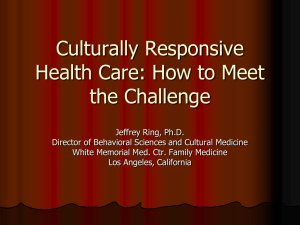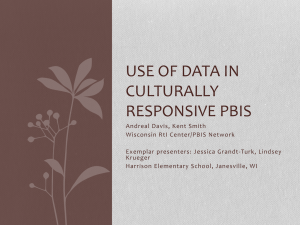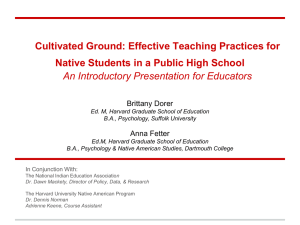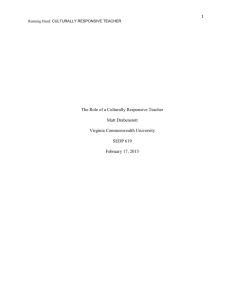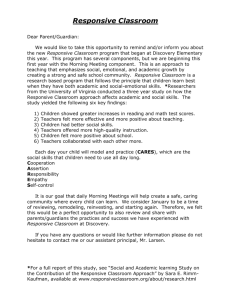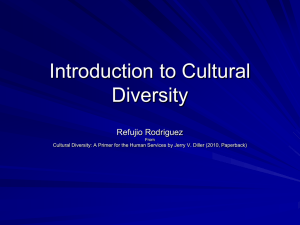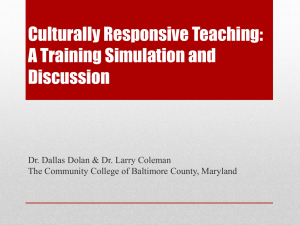File
advertisement
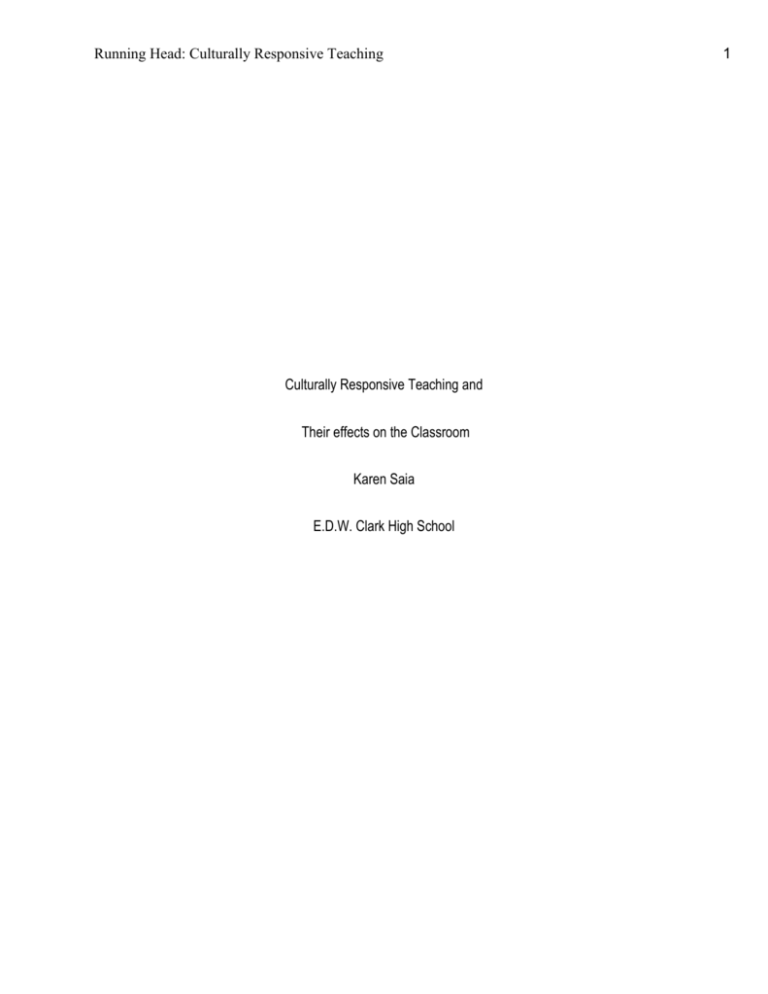
Running Head: Culturally Responsive Teaching Culturally Responsive Teaching and Their effects on the Classroom Karen Saia E.D.W. Clark High School 1 Running Head: Culturally Responsive Teaching Abstract This paper explores the nature of teachers in an ordinary classroom and how to become a culturally responsive teacher (CRT). With three different books exploring the idea of culturally responsive teaching, and a variety of articles stating different conditions needed to be a responsive teacher, this paper describes the qualities a teacher should have in order to maintain a strong and healthy attitude in the classroom. Jacqueline Jordon Irvine, Maria Villegas, Willis D. Hawley, and Michael Vavrus (2002) explored the historical foundations within becoming a culturally responsive teacher. Exploring back into the U.S. Supreme Court and civil rights movements shows the quality in becoming a logical educator. Geneva Gay and Terese C. Aceves in their article, explores the preparation a teacher should take when considering the different racial backgrounds in a classroom. When acquiring the detailed information, a teacher can learn to influence their students to appreciate everyone they encounter in their lives. Teachers prepare their students for the future and which direction would benefit them the most. Keyword: Culturally Responsive Teaching 2 Running Head: Culturally Responsive Teaching Culturally Responsive Teaching and Their effects on the classroom There have been numerous discussions between the idea of race in the classroom and how it has been an issue. In the past racial discrimination has been a topic addressed for years, and today becoming a culturally responsive teacher is a priority set by many educators. Jacqueline Jordon Irvine and Willis D. Hawley explore the abstract of Culturally Responsive Teaching (CRT), and Michael Vavrus examined the historical foundations in the past of culturally responsive teachers. The knowledge and Professional Dispositions are taken with the foundations Vavrus set as well. These qualities and preparations are essential when becoming culturally responsive teachers, and these qualities have been studied not only today, but in the past as well. This paper examines the relationship between Jacquelins et al.’s research about Culturally Responsive Teaching, and how effective it can be displayed in the classroom environment. Literature Review In Geneva Gays (2010) online book describing the preparations for culturally responsive teaching, she demonstrates how a caring community can build the relationship between the students and the teacher as well. Culturally responsive teaching was defined as using the culturally characteristics, experiences, and perspectives of ethnically diverse students as conduits for teaching them more effectively. It was researched that four conditions are main points into creating the culturally responsive classroom environment. First, is to establish inclusion. With this, one must treat all students equally. Second, invite the students to point out behaviors or practices that discriminate between other students. Third, developing a positive attitude toward the individual students encourages discussion of relevant experiences, and incorporates student dialect into classroom dialogue (Gay, 2010). Fourth, enhancing the meaning “encourages discussion of relevant experiences to get the students engaged and thrilled about their 3 Running Head: Culturally Responsive Teaching learning experience” (Gay, 2010). Engender is the last condition in taking that first step toward becoming a culturally responsive teacher. This is the action of including multiple ways to represent knowledge and skill into the classroom, and expressing the different viewpoints within each student. Instructional plans used in schools are called symbolic curriculum (Gay, 2010). Images and symbols add artifacts that are used to teach the students. Bulletin board decorations are models of symbolic representation. Students observe the classroom and view what is represented. The bulletin boards are “advertising space” (Gay, 2010). Gay demonstrates a wonderful point in the opportunity to build an appropriate learning community. Teachers need to know how to do cultural scaffolding-using their own cultures and experiences to expand their intellectual horizons and academic achievement (Gay, 2010). The most influential experience in a student’s life is the experiences their teachers have had in the past, and can relate to the students in many ways. A High School teacher can have a Hispanic background, but can be descended from a long line of African American heritage. This quality within the teacher can show the students that everyone can possess their own cultural background, and it is not something to be ashamed of. Evidence of CRT Terese C. Aceves expanded on Gay’s research and findings with different statistics dating back from 2001 to 2011. A large and increasing number (I,e., 48% in 2011 compared to 39% in 2001) of the student population in the United States came from homes that are culturally linguistically diverse (Aceves, 2014). Addressing the unique needs of CLD students is one of the major challenges facing public education today, because many teachers are inadequately prepared to address CLD students “learning needs” (Aceves, 2014). Aceves as well has her own definition of CRT that draws from the work of Gay (2010). Teachers who utilize CRT practices value students’ cultural and linguistic resources, and view this 4 Running Head: Culturally Responsive Teaching knowledge as capital to build upon rather than as barrier to learning (Aceves, 2014). Aceves looked at culturally responsive teaching in a different perspective, toward social justice. She states, “Cultural Responsiveness goes beyond remedying mismatches from mishandled differences; it uses explicit instruction to help students access valued cultural capital, and it acknowledges that structural inequalities, inhibit diverse students from seceding” (Aceve, 2014). Aceve is trying to say CRT is much more than studying from a book that makes a culturally aware teacher, it is about understanding ones students and exhibiting the different cultural backgrounds each student possesses, because it may influence the way a teacher directs their lesson. Historical Foundations Vavrus et al.’s explored the historical foundations throughout teaching. The U.S. Supreme Court ruled in the 1954 case Brown v. Board of Education, which declared separate schools; public awareness was growing about the cultural discontinuity for African American children and other students of color (Vavrus, 2002). The civil rights movement helped to usher in the concepts and approaches of the modern reform movement of multicultural education. The idea of becoming a culturally responsive teacher has been around since the 1900’s, and the concept continues to grow stronger. Multicultural educators have consistently stressed the need for teachers to expand their cultural competence in relation to their own dispositions, knowledge base, and performance skills (Vavrus, 2002). This expectation is a teaching force with a deeper understanding within the school curriculum to a pluralistic society with paying attention to the need of other students with color (Vavrus, 2002). Villegas (2002 ) states, “teacher education programs have typically responded to the growing diversity among K-12” and have adding a couple courses on multicultural education, still leaving the common curriculum intact. Learning to be a culturally responsive person does not only direct to teachers, but to students as well. Villegas (2002) explained that over the past thirty years, elementary and secondary student populations grew increasingly diverse. This steady trend 5 Running Head: Culturally Responsive Teaching was evident in the figure he provided (See figure 1.1). This presents the percentages of white and colored students in public schools for selected years, beginning with 1972. By 1998, they constituted over one-third of the student population. 6 Running Head: Culturally Responsive Teaching Conclusion In order to fully understand the qualities needed for becoming a Culturally Responsive teacher, one must practice and experience it for themselves. The different steps a teacher must take is influential for the students academically and socially. Gay influences teachers to become culturally aware and use experiences outside of the classroom, for the students’ to understand that being culturally different should never stand in the way of someone’s education. Within the historical context that Vavrus (2002) provided, multiculturalism has been an issue for decades, and now that teachers have the opportunity to progress in their teaching skills, becoming a culturally responsive teacher should be easy and beneficial for everyone. Teaching without any knowledge of the student’s background can affect the way a child learns, and it is up to the teacher to understand their position on the way they view their culture and the students’ as well. 7 Running Head: Culturally Responsive Teaching References Aceves, Terese. (2014). Increasing the involvement of culturally and linguistically diverse students in special education research (p. 37). Arlington, Virginia. Vavrus, Michael. (2002). Multicultural education: Historical development, dimensions, and practices (James A. Banks ed., p. 24). San Fransisco, California. Gay, Geneva. (2000). culturally responsive teaching: Theory, research, and practice (2nd ed., Vol. 53, p. 113). New York City, New York. Villegas, Maria. (2002). Educating Culturally Responsive Teachers. Albany, New York. Gay, Genveva. (2002). Preparing for Cultrually Responsive Teaching. Seattle, Washington. 8 9 Running Head: Culturally Responsive Teaching Appendix A Themes of CRT The literature as Aceves indicates that CRT can have a powerful impact on CLD students’’ development because it provides teaching that draws from CLD students’ relevant schemas, background knowledge, and home languages; it also allows students to practice what they are taught (Aceves, 2014). Aceves reviewed studies that examined instructional practices with K-12 student outcomes. Aceves found six general CRT themes (i.e., instructional engagement; culture, language, and racial identity; multicultural awareness; high expectations; critical thinking; and social justice) The CRT literature supports the findings (see Table 1). Table A1 Culturally Responsive Teaching Practices Relevant Themes of CRT Emerging Evidence-Based CRT Practices Recommended CRT Approaches and Considerations Instructional Engagements Collaborative Teaching Problem- Solving Approach Culture, Language, and Responsive Feedback Child-Centered Instruction Racial Identity Multicultural Awareness Modeling High Expectations Instructional Scaffolding Critical Thinking Assessment Materials Running Head: Culturally Responsive Teaching Appendix B This presents the percentages of white and colored students in public schools for selected years, beginning with 1972. By 1998, they constituted over one-third of the student population. Villegas (2002) expresses the graph in a way that examines how the racial differences have become increasingly different from the year 1972 to 2006. Examining how the population grew and dropped within different cultures, presents a good idea of what kind of racial background our country has. It is important to understand that not all students are going to have the same racial background as the teacher, so teachers need to be culturally aware how different a classroom can be with different cultural backgrounds. 10
